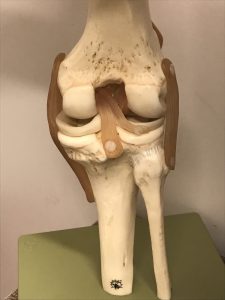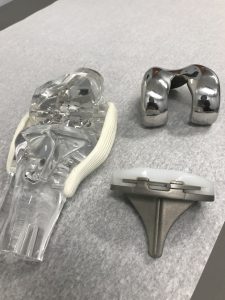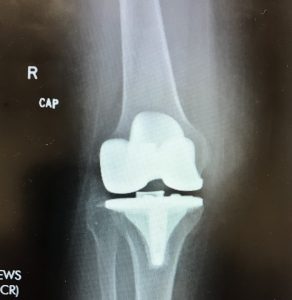KN, p. 314 “Does Your Protagonist Need Total Knee Replacement?”
If there are no paragraph separations, please double-click on the title to create a more readable version.

Twelve years ago, Kerrian’s Notebook came to life because of several bullets that managed to find their way into my body during a drug bust gone bad. Yup, I was injured on the job. The bullet holes healed, but bones were broken during that same shootout and intense rehab began. I was out of commission for over a year, bored and with a bad attitude, until I found that people were interested in what I had to say about life as a law enforcement officer. I could focus on something besides quad lifts and stretching.
I did get back on the job on limited duty at first, then went back fulltime as a Detective when the doc cleared me around the 18 month point. Truth be told, I lost a step in the ‘racing after the bad guys’ part of the job when we caught a runner, so I mostly left that to younger partners with better knees. Light repair surgery took care of torn ligaments, but a few months ago, total knee replacement became a necessity when Osteoarthritis settled into my achy bones.
You know me, I asked the Doc a LOT of questions pre & post surgery. My surgeon builds the knee replacement device to fit the specific patient on the day of the surgery. Other surgeons take the one-size-fits-most approach.

During my total knee replacement surgery, any remaining damaged cartilage was removed. The end of the thigh bone and the top of the lower leg bone were sliced off to create a flat surface, then areas drilled out to accommodate the titanium implants. Those implants were press fit (inserted) into the bones where the two bones join together, then Palacos Bone Cement was used to permanently attach the implants to the existing bone. Fun fact: the cement is green.
My own ligaments and tendons are still there. A plastic spacer (replacing the long gone cartilage) was inserted between the metal pieces to create a smooth surface, making it easier for the bones to glide against each other. The result should be that my stride will return to normal.

Recovery has taken longer than the average Knee Replacement Surgery since I have bowed legs. Because of that, one of the bones needed to be turned a bit during the surgery, allowing the knee apparatus to line up properly with the thigh and calf bones.
Surgery took a little over two hours. The brochures state that each person/situation/surgery is different. Yup. I’ve had stabbing pain in my knee cap, like somebody stuck a screwdriver in it. Repeatedly. I had no feeling in a large section below the surgical spot for about three months, making rehab a tad strange at times. The knee was massaged, iced, rotated, pulled on, you name it, we tried it. Then finally, when feeling partially returned, I began to make real progress with stairs, standing to get out of chairs, etc. After five months, my knee function is returning to normal, slowly, but getting there.
Physical therapy consists of strengthening the muscles above and below the knee. Quad lifts, leg lifts, all manner of moving that leg to get the body used to the new thing invading the space. Occasionally, the knee buckles, due to weaker-than-they-should-be quad muscles. We’re working on that. Sometimes, I hear/feel clicking when I walk. That’s normal.
Balance issues do occur as the body adjusts to its new position in space. One leg is marginally shorter than the other. After the other knee gets replaced in a few months, the body will adjust again.
If your legs are physically toned before the surgery, recovery is easier. If you sit around the house a good part of your day, then rehab will take longer. Sometimes, people are allergic to the metal being used in the implants, infection sets in, and the surgery has to redone. Sometimes, scar tissue builds up, locking the knee in place, and the surgery has to be redone.
Attitude is everything in recovery from any major surgery. Younger patients (below 50) will recover more quickly than older patients, based mostly on physical fitness and willingness to do the demanding rehab.
Several TV shows and movies have included injured characters in the storyline. The protagonist is reluctant to go under the knife ostensibly because the team will have to work without their leadership. People hem and haw over the decision, with lots of drama involved. BUT, what’s really going on with the reluctant patient is that they will miss doing the job they love to do if anything goes wrong. If you write an injured character into the plot, don’t forget the emotional toll that major injury causes. The worry and sleepless nights are real. However, if the character needs a legitimate excuse to leave the job, the damaged bones can be a hidden gem.
Think Jason Hayes in the popular military TV show, “Seal Team.” During the third season, to avoid going under the knife, he had PT after wrecking his knee. Eventually, he followed the doc’s initial advice and had the work done. He needed a minor, rather than major repair, only missed one mission, and his anxiety level dropped dramatically.
If you or anyone in your circle sustains an injury, use it in your stories. Courage in the face of months of recovery, fears, tension, the effect on loved ones (good and bad) who have to change their routines to help? It might not be fun in real life, but it all works on the page.
*Charlie Kerrian is a fictional character, but this knee replacement story is real and rehab is ongoing.
KN, p. 314 “Does Your Protagonist Need Total Knee Replacement?” Read More »







